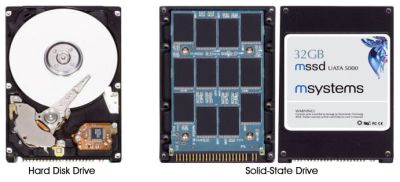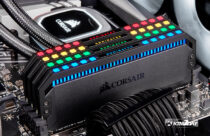Solid-State Drive


A solid state drive (SSD) is a data storage device that uses solid-state memory to store persistent data. An SSD emulates a hard disk drive, thus easily replacing it in any application. An SSD using DRAM or SRAM (instead of flash memory) is often called RAM-drive.
DDR SDRAM based SSD
The original usage of the term solid state (from solid state physics) refers to the use of semiconductor devices rather than electron tubes, but has in this context been adopted to distinguish solid-state electronics from electromechanical devices as well. With no moving parts, a solid state drive is usually more robust, effectively eliminating the risk of mechanical failure, usually silent, and usually enjoys reduced seek time and latency by removing mechanical delays associated with hard disk drives.
The advent of Serial ATA has meant that a RAM drive can be connected as a hard disk drive and used as such with extremely high transfer speeds. An example is the Gigabyte i-RAM, Hybrid Ram Disk, which uses standard DDR modules and connects to its host via SATA. This card also can use the system’s standby power (also used for Wake-on-LAN and similar features) to maintain its RAM contents even with the system powered off, and even includes a battery that can retain the data when the system is completely disconnected from the power supply.
Compared with hard disk drives (HDDs)
Advantages
1. Faster startup – as no spin-up is required.
2. Near random access – since there is no read/write head to move.
3. Extremely low read and write latency times – SSDs seek times are orders of magnitude smaller than the best current hard disk drives.
4. Faster boot and application launch time .
5. Lower power consumption and heat production .
6. No noise – Lack of moving parts makes the SSD completely silent.
Disadvantages
1. Price – as of early 2008, around US$15 per GB compared to typically less than US$1 for mechanical drives.
2. Capacity – though currently far lower than that of conventional hard drives, SSD capacity is set to increase rapidly. At CES 2008, BiTMICRO Networks announced the release of SSDs with capacities of up to 832GB, for release in Q3 2008. On February 5, 2008, BiTMICRO Networks announced that they had managed to pack a record-breaking 1.6 TB into a 3.5″ SSD, the E-Disk Altima E3S320.
3. Higher vulnerability to certain types of effects, including abrupt power loss (especially DRAM based SSDs), magnetic fields and electric/static charges compared to normal HDDs .
4. Limited write cycles – typical Flash storage will typically wear out after 300,000-500,000 write cycles, while high endurance Flash storage is often marketed with endurance of 1–5 million write cycles . SSDs based on DRAM, however, do not suffer from this problem.
5. Slow random write speeds – as erase blocks on flash-based SSDs generally are quite large, they’re far slower than conventional disks for random writes. SSDs based on DRAM do not suffer from this problem.















